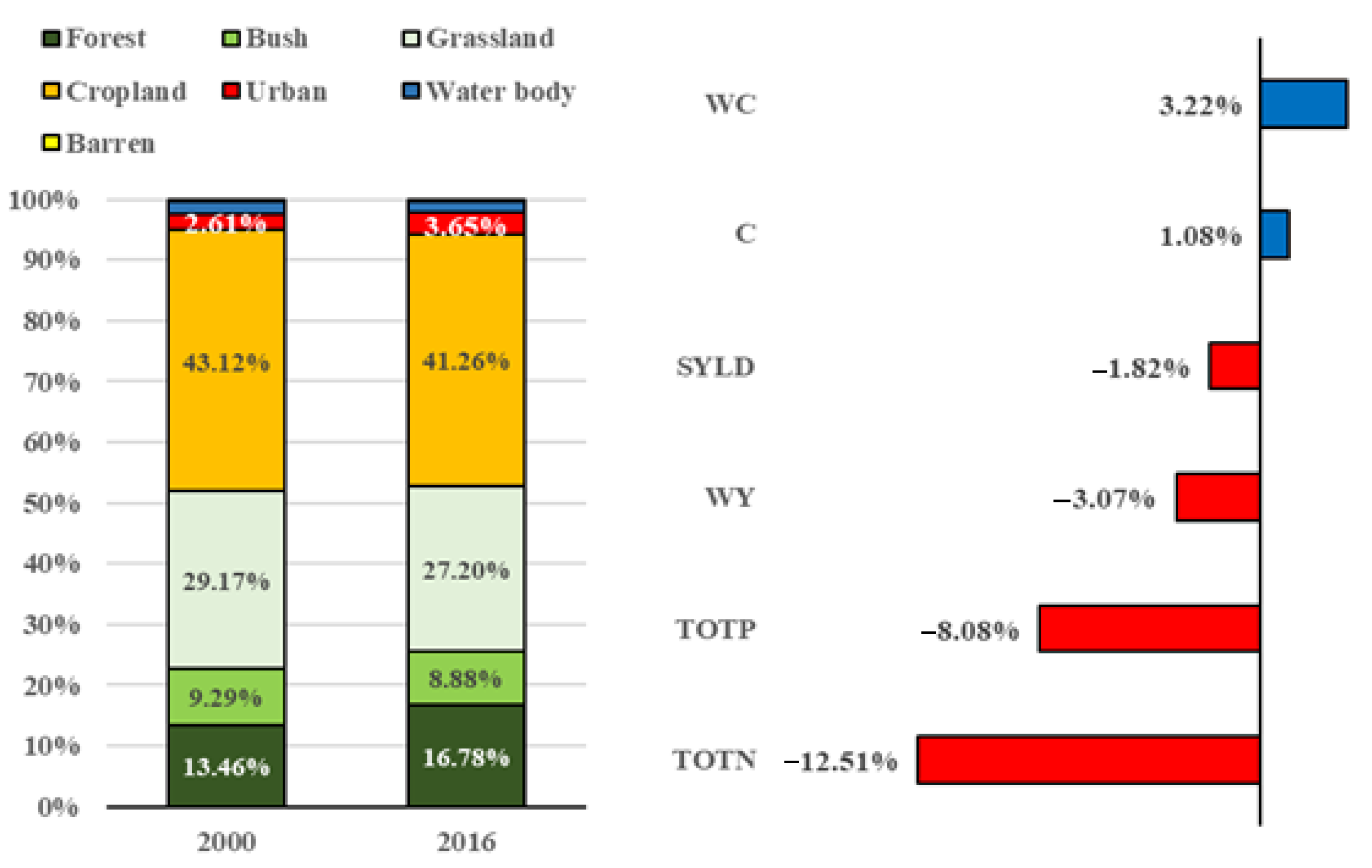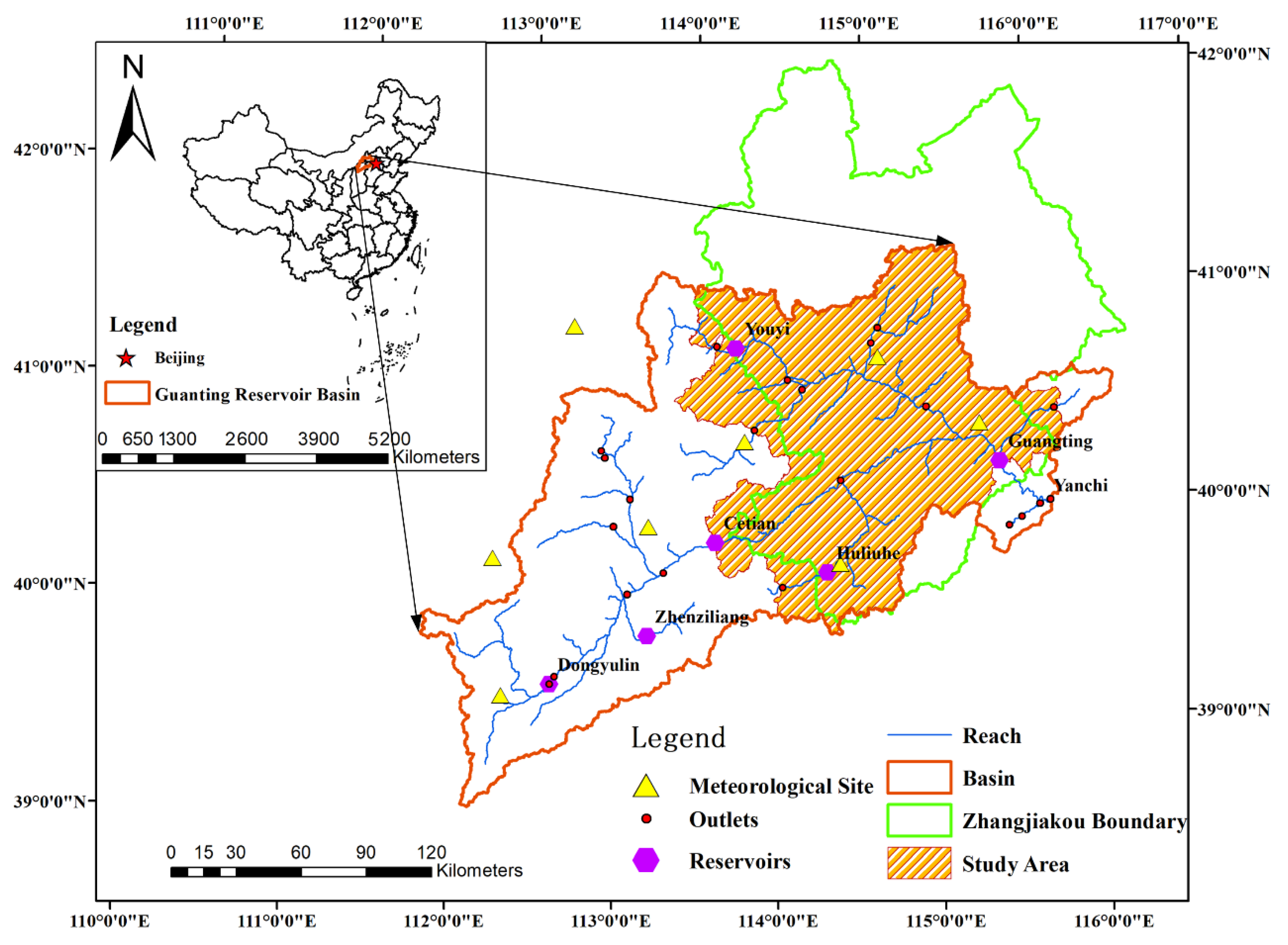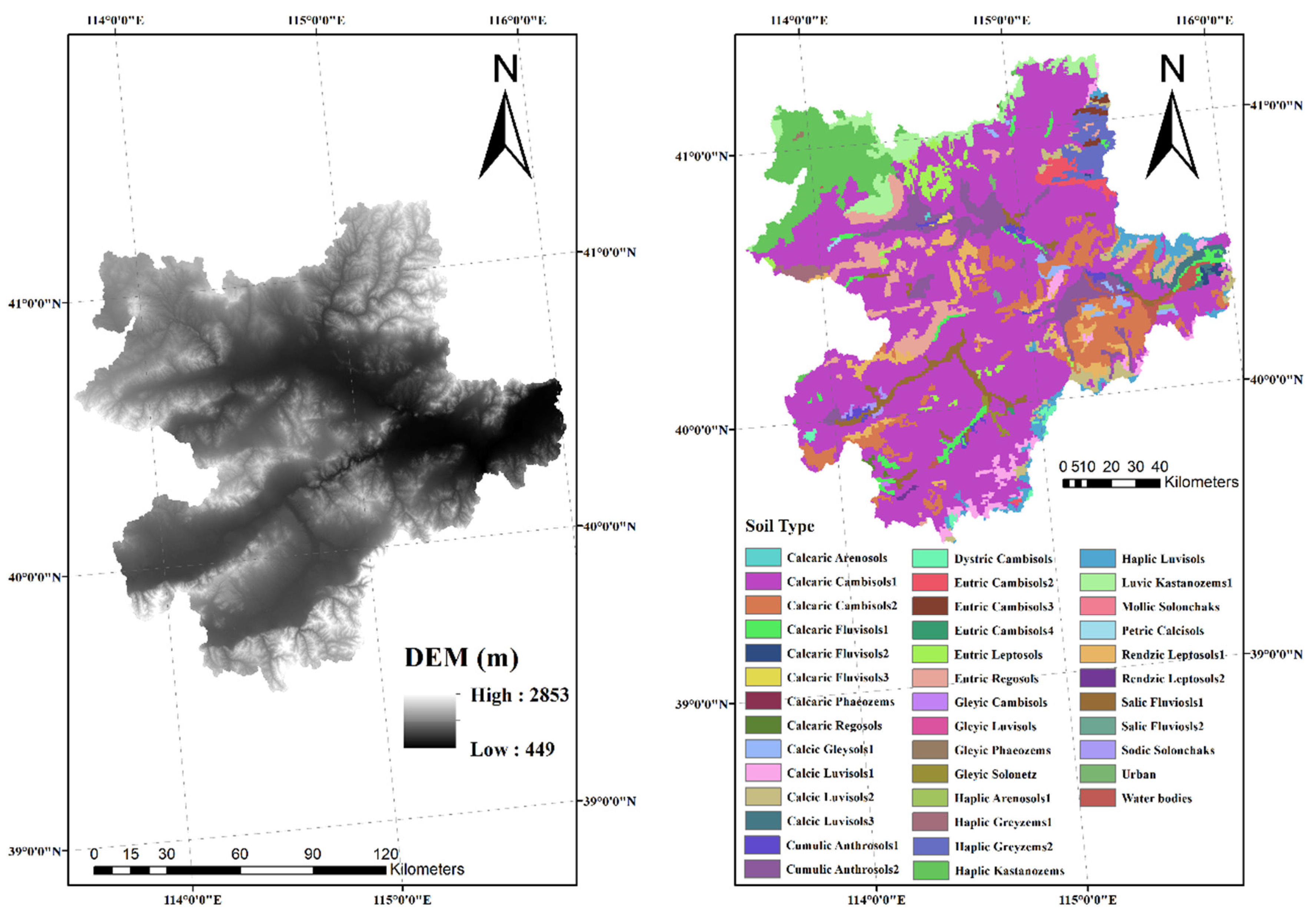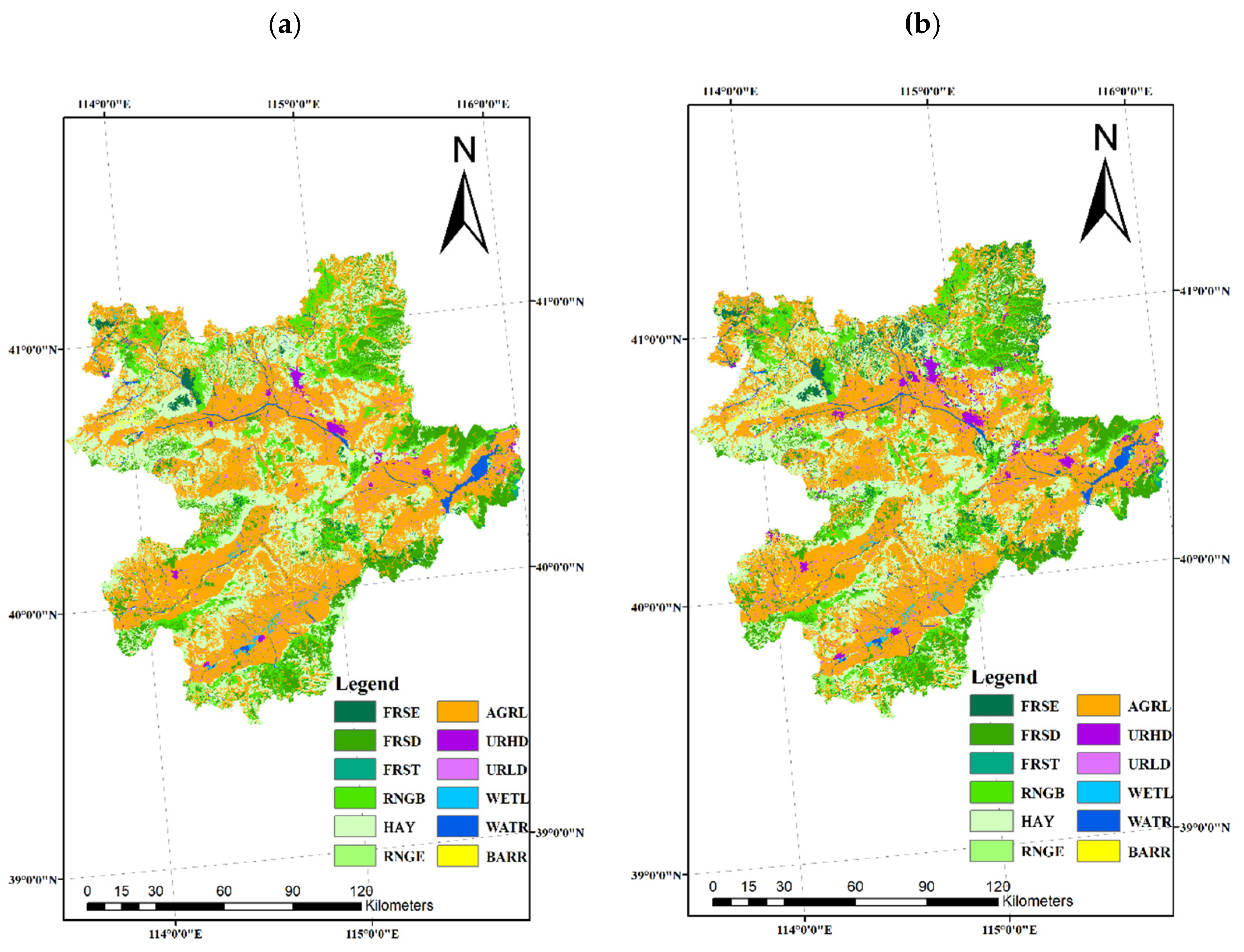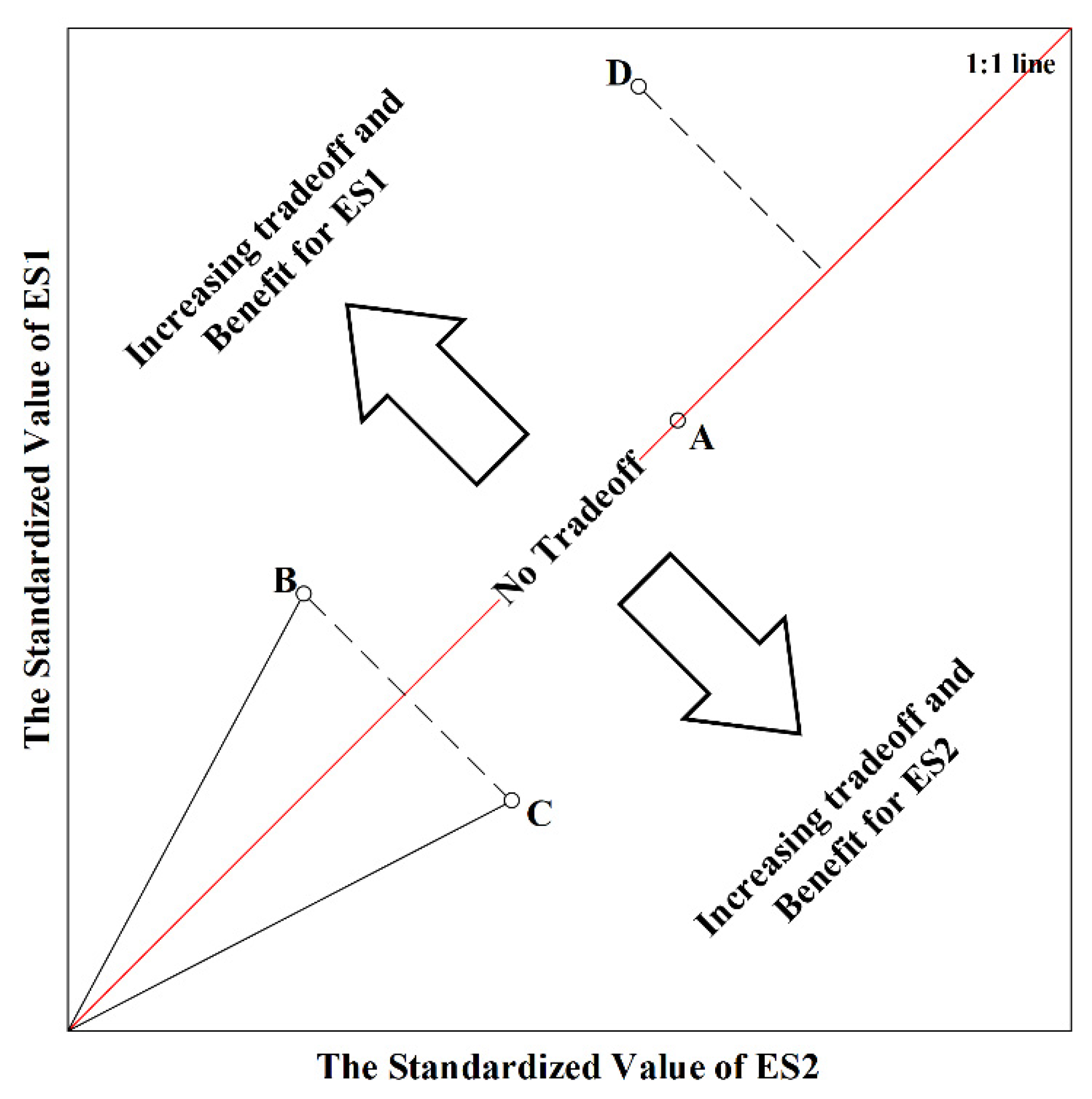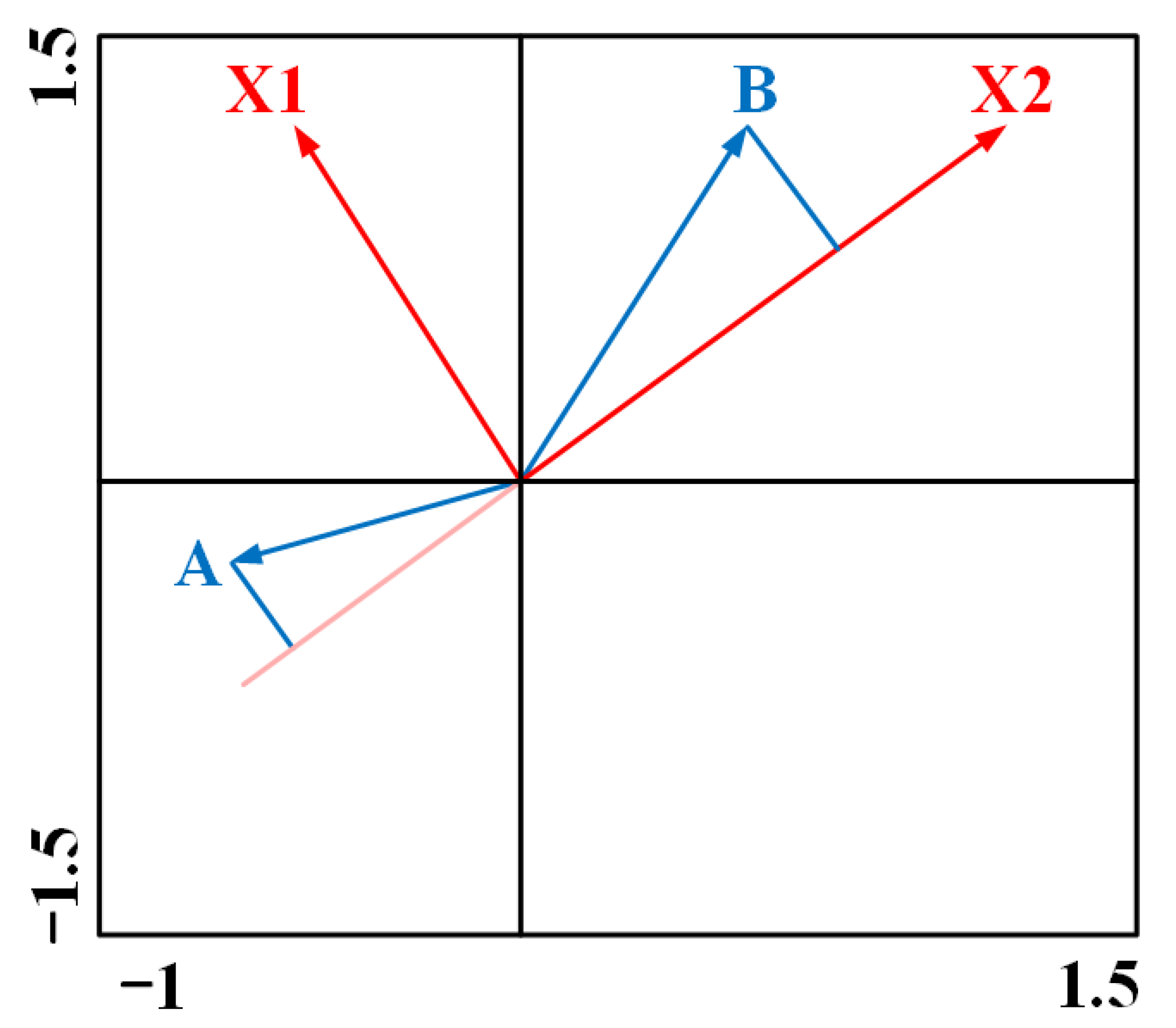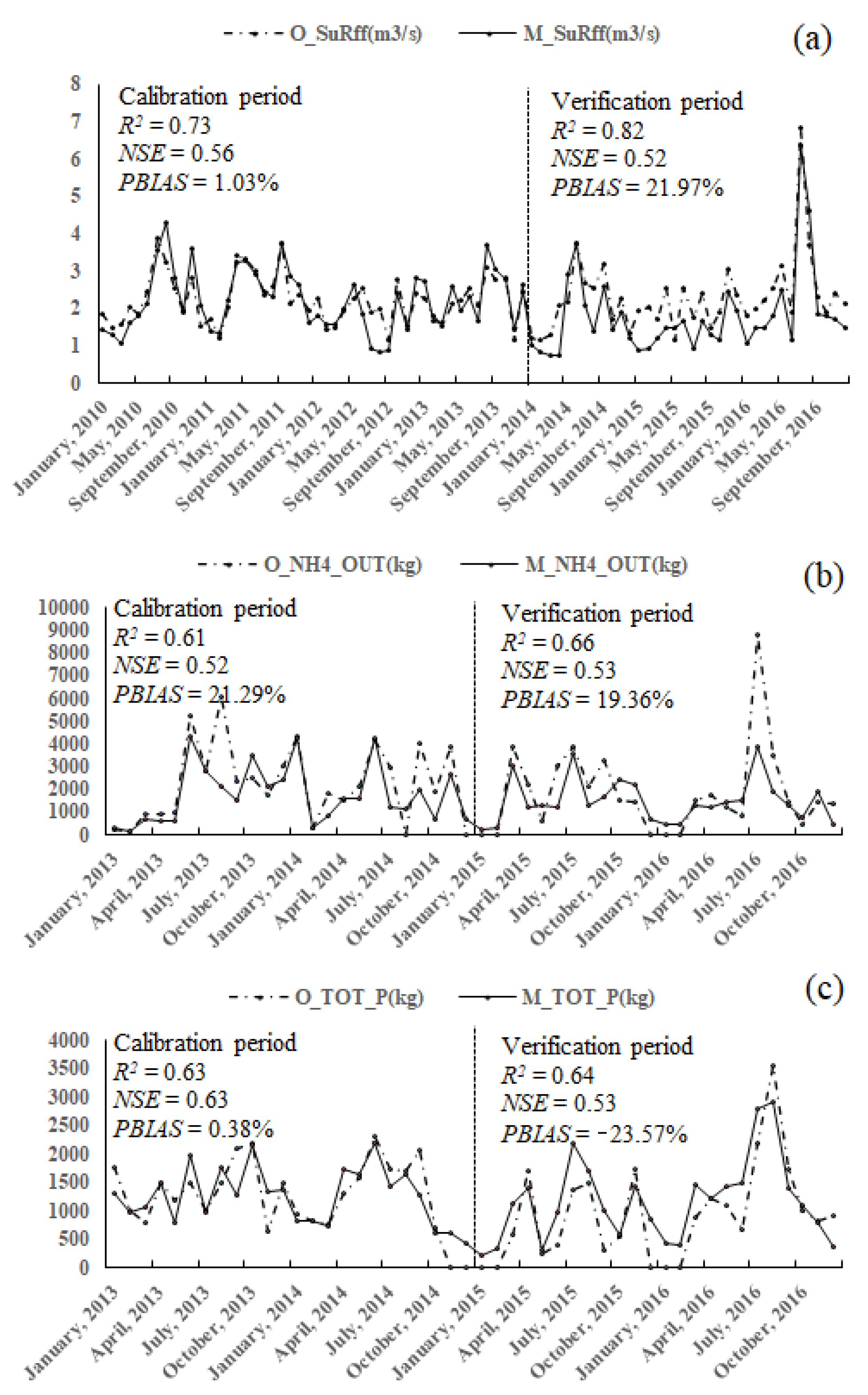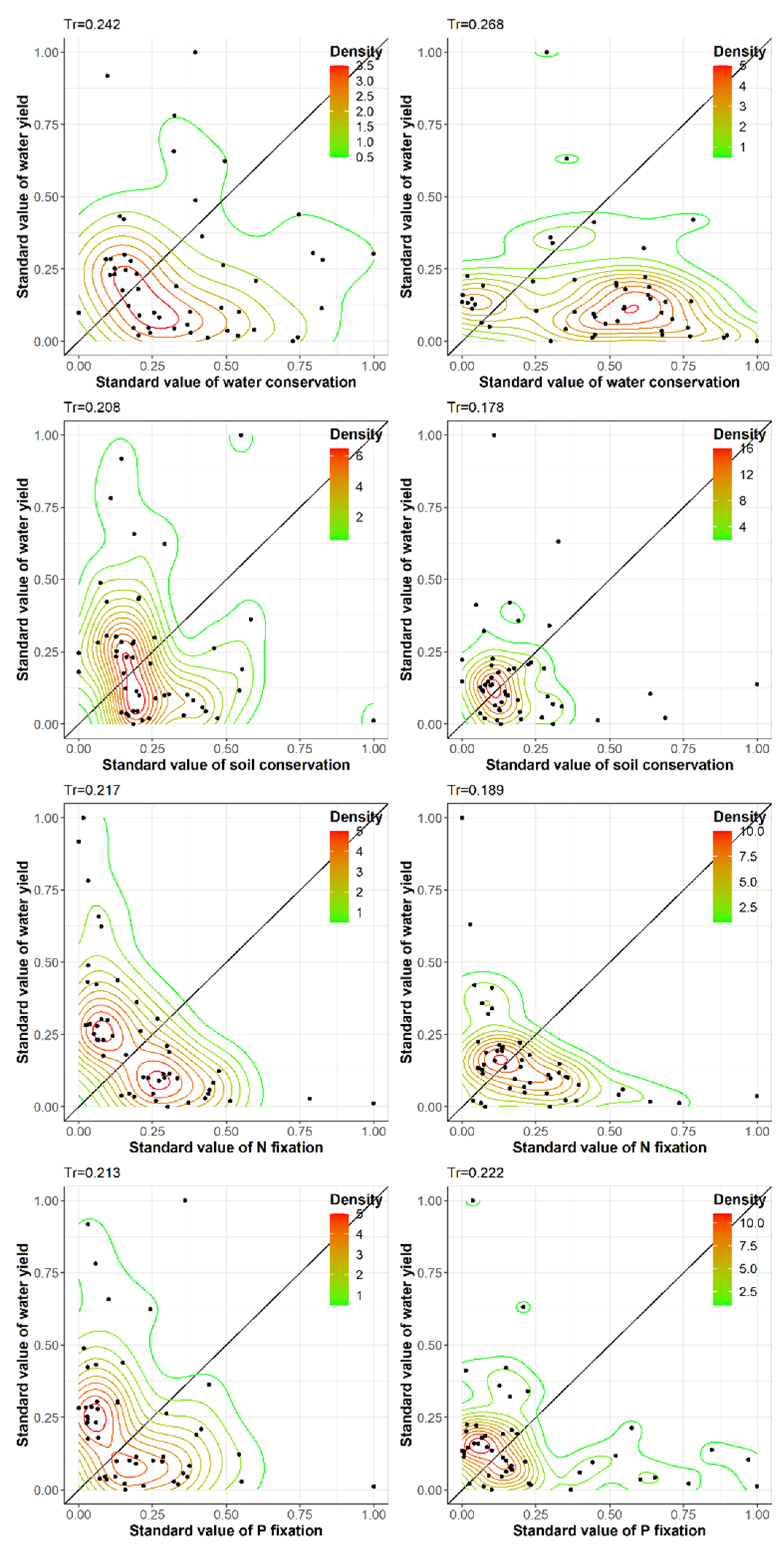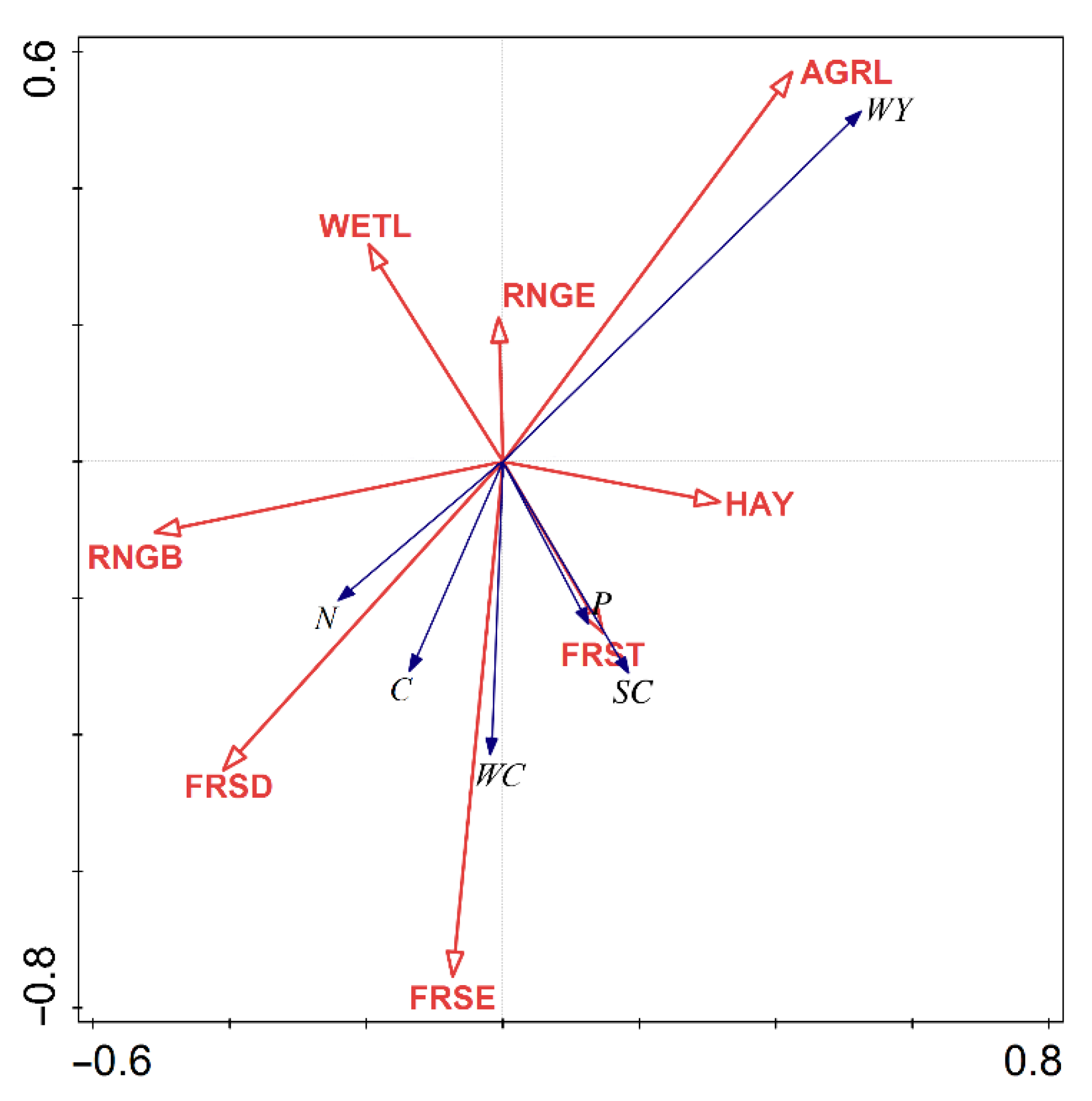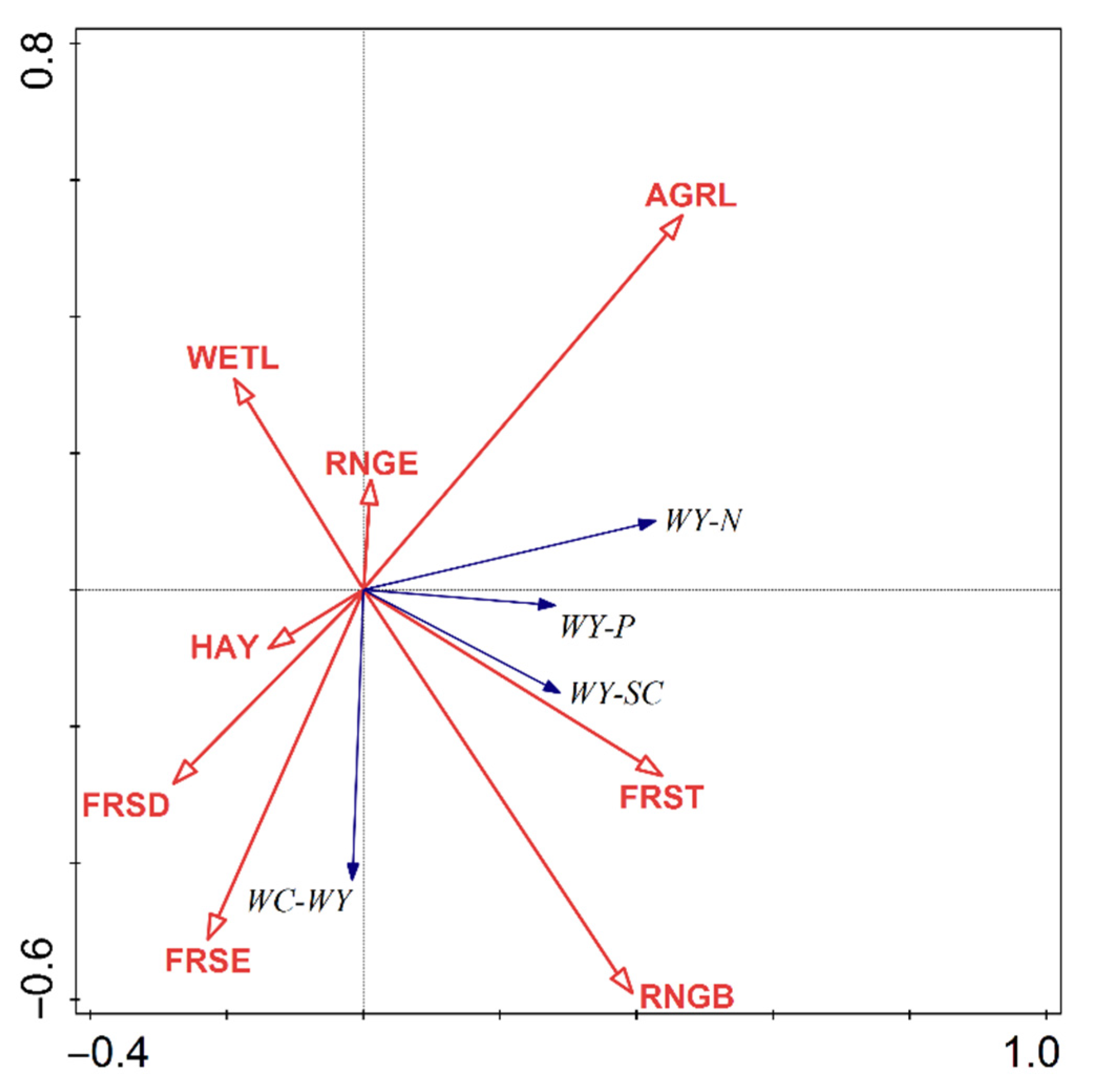1. Introduction
Ecosystem services (ESs) are the benefits that humans derive directly or indirectly from ecosystems [
1] that enhance human livelihoods and provide the basis for sustainable development with rational exploitation [
2,
3]. According to the Millennium Ecosystem Assessment Program, ESs can be classified into four main types, namely provisioning, supporting, regulating, and cultural services [
4]. ESs are not independent of each other, and the two main kinds of relationships between different ESs are tradeoff and synergy [
5]. A tradeoff usually enhances one ES over the consumption of other ESs [
5,
6]. Synergy, as opposed to tradeoff, is a situation in which two ESs are enhanced or degenerated simultaneously [
5,
7]. Regional development policies are guided by people’s demand for ESs, which leads to impacts on other ESs while pursuing one or more ES [
8]. Ignoring relationships between ESs may threaten the stability and security of an entire ecosystem [
9].
Over the past 50 years, 60% of the world’s ESs have been degraded [
10], with problems such as soil erosion, desertification, and biodiversity loss. In the past four decades, a series of ecological and environmental construction projects with huge investments and significant contributions have been launched in China and the world, including notable afforestation projects such as the Three North Shelter Forest Program, the Natural Forest Protection Program, and the Grain for Green Project [
11,
12]. Zhangjiakou City is the frontier of the Beijing–Tianjin–Hebei region and is facing the hazards of wind and sand; as such, it was involved in all these projects. Moreover, it is located upstream of the Yongding River, which is the main water source for Beijing. The quality and quantity of water resources in Zhangjiakou are key factors to restoring the water system and supporting ESs of the Beijing–Tianjin–Hebei region. However, irrational agricultural management in recent decades has strongly affected regional water resources. The increase in irrigation area is accompanied by an increase in fertilizer and pesticide application, which increases the risk of water pollution in the watershed [
13]. Previous research suggested that afforestation reduces the water yield (WY) [
14,
15], but it could help to purify water by holding back nutrients from entering the water system [
16,
17], and it also contributes to mitigating climate change by fixing carbon [
15]. However, some studies have suggested that forests may lead to tradeoffs between ESs [
18,
19]. Recognizing the trade-off mechanism of ESs caused by afforestation, in particular those related to the water system, is critical to the development of land-use strategies for better ecological restoration in Zhangjiakou City and other regions with overlapping afforestation and agricultural development.
Estimating the response of multiple ESs to ecoengineering implementation and establishing a sustainable balance between different ESs have emerged as a new research field [
20]. Studies are carried out on different processes, such as agricultural management pattern change [
21,
22], urbanization [
23,
24], and ecological restoration [
25,
26]. The research covers ecoengineering projects, such as agricultural land consolidation and the Grain for Green Project (GFGP), all of which are effective in improving some ESs, but which have exacerbated tradeoffs [
18,
27,
28,
29,
30,
31]. However, in some areas, ecoengineering implementation can also enhance certain ESs without sacrificing others [
32].
Afforestation projects contribute to regional sustainable development by changing regional land use and altering ecosystem patterns and processes, which lead to ES optimization [
20,
33]. The quantified expression of ecosystems and the analysis of ESs’ relationships are a guarantee for the development of scientific management policies [
34]. Therefore, ES assessment and relation analysis are widely used in land-use policy development and management practices [
35,
36,
37]. Quantification and trade-off analysis of ESs are key techniques used before land-use planning, management, and decision making [
27,
29,
31]. Ecosystem process models, combined with the remote sensing technique, provide the basis for quantitative spatial representation of ESs and can be used to study the effects of future land-use change on a series of ESs interrelationships [
38,
39,
40].
To help decision-makers develop regional land-use planning schemes, numerous studies have recently started to explore the impact of ecological projects, such as reforestation, on ESs and their relationships. The two main research methods are as follows: (1) Field surveys in different regions or building ecosystem models to obtain ES characterization indicators; the ability of different land uses contributing to ESs and the impact on ES relationships are analyzed according to the natural environment [
19,
41]. This is a static method. (2) The ecosystem model is used to simulate ESs under baseline and different optimization scenarios to find the one with the most significant ecosystem enhancement effect and the fewest tradeoffs to use as a reference for future land-use planning [
42]. This approach is a pseudo-dynamic approach, which compares various static scenarios and draws conclusions. In reality, land-use change and changes in ESs and their interrelationships are dynamic; such dynamics can rationally be reflected through the analysis of the relationship between land-use change and ES change. Current research focuses only on finding the scenario that achieves more ecological benefits, not on changes in ESs and their relationships when scenarios are switched; such a method cannot determine what kind of land-use change scenario, or combination of scenarios, can improve the regional ecological environment. Finding land-use change patterns that are conducive to ecological development is a necessary step in determining land-use optimization scenarios.
The following three questions were addressed in this study: (1) Has the current planning program for land use in the study area improved the regional ecological environment? (2) How has the change in land use affected ESs and their relationships? (3) Is there a land-use change pattern that enhances ESs without tradeoffs? If not, what land-use planning scheme would satisfy the different ecological improvement needs? To address these questions, we quantified four ESs (WY, water conservation and soil conservation, nonpoint pollution control, and carbon sequestration) using the soil and water assessment tool (SWAT) model; next, we clarified relationships, in particular tradeoffs between ESs that affect the sustainability of regional ecosystem development. Finally, we dynamically investigated the relationship between changes in ESs and their interrelationships with land-use changes, and we discussed the implications for future land-use management. The integrated dynamic analysis of ESs relationships will provide references for the evaluation of regional afforestation projects and the formulation of future land-use policies under different demands.
4. Discussion
Afforestation is a powerful anthropogenic intervention, adjusting and rearranging land management practices. It aims to achieve sustainable development by changing regional land use and is widely implemented in several countries around the world. Studies have shown that afforestation improves ecosystem regulation services and the quality of local ecosystems [
29,
70]. However, some studies have also found that the tradeoff between provision and regulatory services will become increasingly evident with the implementation of GFGP [
71,
72].
Therefore, the complexity of the trade-off relationships between ESs under afforestation projects needs to be considered to understand the integrated benefits of afforestation, which is critical for promoting the sustainable development of services in each ecosystem. In terms of synergies and tradeoffs between ESs, the tradeoff between WY and other ESs is one of the challenges that constrain sustainable development [
73]. When tradeoffs are unavoidable, the selective change in land-usage strategies according to regional ecological development requirements is an effective way to maximize ecological benefits.
The results of this study are very similar to those of previous researchers in terms of ESs and their interrelationships. For example, in Yunnan, which is located in the tropical monsoon climate zone of southwest China, the GFGP also enhanced the local carbon sequestration and water conservation functions by 3.49% and 0.83%, respectively, while decreasing the water yield by 0.83% [
18]. In Shandong province, which is located in a temperate monsoon climate zone in eastern China, studies have shown that the GFGP can significantly improve the control of nonpoint source pollution [
74]. Another study in Yunnan Province showed that the GFGP would effectively contribute to the enhancement of soil retention, but at the cost of a decrease in streamflow production [
29]. Water yield in Nanjing, located in the subtropical monsoon zone, increased by 33.03% from 2005 to 2010, while carbon sequestration and soil conservation decreased by 0.75% and 7.75%, respectively, forming a trade-off relationship between these ESs [
73]. An assessment of ESs in southern China using the InVEST model found a significant synergistic relationship between water yield and nitrogen and phosphorus export, suggesting a trade-off between water yield and pollution diffusion control [
75]. In the Heihe River Basin, which is located in a temperate continental climate zone in northwest China, synergy between water conservation, soil conservation, pollution control, and carbon sequestration is a dominant relationship [
66]. A study in the YLN basin (the basin of Yarlung Tsangpo River, Lhasa River, and Nianchu River) in Tibet, which is located in a mountain plateau climate zone, indicated a significant synergistic relationship between water conservation and both carbon sequestration and soil conservation [
76]. Most of the characteristics of ESs and the relationships between them were the same as those obtained in previous studies in different climate zones. The synergistic WC–SC relationship observed in 2016 differs from some previous conclusions [
77], but it has also been pointed out that the implementation of ecological projects changes the WC–SC tradeoff relationship [
77,
78]. The implementation of afforestation projects in the study area enhanced both WC and SC, making the relationship between them develop in a synergistic direction.
Over a long period of time, the characteristics of changes in ESs and their relationships are similar to this study, while the main influencing factors of these changes evolved significantly. In the analysis of the relationship between flow production, water purification, soil conservation, carbon sequestration, and habitat quality in the South Four Lakes Basin of Shandong Province from 1980 to 2018, it was found that, with the increasing area of land for construction in economic development, the water yield is becoming stronger and flood risk is increasing; the strength and direction of ESs relationships change over time, and the trade-off between water yield and water purification is always the most obvious and exacerbating [
79]. In terms of changes in the relationship between supply and regulating services in each administrative region in the Greater Bay Area from 2000–2015, the overall relationship is dominated by synergies with varying degrees, and it is accompanied by the occurrence of trade-off relationships of varying degrees [
80]. Analysis of the factors influencing ES changes in the Heihe River Basin from 1980–2010 found that climate change factors on larger time scales had a more significant impact on water-related ESs than land-use changes [
81].The contribution of different land uses to ESs was different. Land uses with a good canopy structure can effectively improve the regional ecological environment but may also result in more drastic tradeoffs. In the study area, FRSE exacerbated the WC–WY tradeoff because of a relatively weak negative effect on WY and a strong positive effect on WC. Compared with other land uses, FRSE is more suitable for planting in areas where WC and NF fixation are needed. FRSD has an average WC capacity, but it can enhance CF and reduce WY, and planting FRSD is a good choice when runoff regulation and carbon fixing are needed. The contribution of FRST to different ESs is quite different [
41], which leads to multiple tradeoffs. Considering the coordinated development of the ecological environment, FRST is not suitable in areas with similar climatic conditions and topographical features as the study area. In terms of water retention, soil sequestration, and nitrogen and phosphorus diffusion control, RNGB and FRSE have similar tradeoff characteristics, but RNGB has a smaller contribution [
64,
82]. RNGE does not contribute significantly to any ES or tradeoff compared with other land-use types in the study area. Some studies have pointed out that shrubs can make a prominent contribution to soil organic carbon accumulation. Studies suggested that soil carbon accumulation is affected by soil type. In soils with a high sand content, trees are more conducive to organic carbon accumulation. By contrast, shrubs are more likely to accumulate organic carbon in soils with more silty clay particles and agglomerates [
64]; 10.09% of the shrubs in the study area were planted in areas with a high soil sand content, which may be the reason for the shrubs not fully performing their ecological functions. Conversion of shrubs planted on sandy soil to other land uses can be considered when afforestation is carried out to improve ESs. HAY contributes to all ESs except CF and NF. Because of its weaker capacity of enhancing CF and NF, with the constant study area, an increase in the HAY area leads to a relative weakening of ESs. Meanwhile, HAY exacerbates the weakest tradeoffs [
19]. HAY can enhance multiple ESs without exacerbating too many tradeoffs; considering the integrated development of regional ecosystems, partially changing land use that deteriorates the tradeoffs to HAY may be an effective method to maintain ESs while preventing overconsumption of other ESs. The specific ecological problems and corresponding solutions are shown in
Table 8.
Soil pH affects soil fertility; intense nitrogen deposition is the main reason for soil acidification, and land-use-type conversion is the main factor affecting soil properties [
83,
84]. While studying the control of nitrogen and phosphorus surface source pollution by land-use policies, it is also necessary to extend the focus to the nitrogen and phosphorus content in soils to form a theoretical support for future land-health-restoration strategies. The influencing factors of different ESs vary at different spatial scales; human activities are more likely to affect ESs at small scales. At larger scales, the influence of environmental factors are dominant [
85]. Similarly, the factors influencing ES relationships differ across time scales; long-term ES changes are more sensitive to climatic elements. This study checked changes in meteorological factors, resulting in a relatively low cumulative explained variation of the RDA. Water-related ESs are highly sensitive to precipitation and temperature [
41], and meteorological elements should be considered in future studies to further complete the analysis of factors influencing ESs. The change patterns of ESs with time are becoming clear, and the next step is to analyze the ESs and their interrelationships at different time intervals to find the time scales that are sensitive to changes in ESs and their relationships, which can help in formulating a more comprehensive land-use strategy under the goal of the sustainable development of ESs. Moreover, the effects of environmental factors on tradeoffs can be statistically described by RDA, but individual ESs are influenced by multiple land uses, and each land use affects multiple ESs. Besides, ESs are not isolated from each other, and relationships that exist between ESs will blur the judgment of factors influencing ESs relationships [
8]. The response mechanism of ESs and their changes to land-use changes needs to be further studied.
5. Conclusions
In this study, we quantified four ESs (water yield, water and soil conservation, nonpoint pollution control, and soil carbon sequestration) of Zhangjiakou in the Guanting Reservoir basin by the SWAT model. Changes in different ESs and the tradeoffs between them were analyzed; then, we further analyzed the response of changes in tradeoffs to land-use changes caused by afforestation projects. The afforestation project changed ESs and relationships between ESs by changing land uses. With changes of land use, water conservation and soil carbon content have increased, whereas those of WY, sediment yield, nitrogen and phosphorus loss have decreased. The regional ecological environment has improved. Significant tradeoffs occur between WY and other ESs, except soil carbon sequestration. The intensity of the tradeoffs has changed. Tradeoffs between WC and WY, and phosphorus loss control and WY were exacerbated, whereas tradeoffs between SC and WY, and nitrogen and WY were mitigated.
Several ESs have been enhanced at the cost of WY in the study area. When tradeoffs cannot be avoided, we should focus on ESs that need to be enhanced urgently and bring forward a corresponding land-use planning scheme by selecting one or several land-use combinations under the premise of causing no excessive losses of other ESs. Mixed forest has the function of SC and phosphorus loss control, but it exacerbates too many tradeoffs, so mixed forest not a suitable afforestation species from the perspective of ecological sustainable development. Planting evergreen forest is not only an effective way to enhance WC, but it also benefits nitrogen loss control. Planting a deciduous forest can control WY and enhance soil carbon sequestration. Grasslands contribute to multiple ESs and do not excessively exacerbate tradeoffs. Replacing land-use types with strong tradeoffs with grassland can help achieve a synergistic development of ESs.

